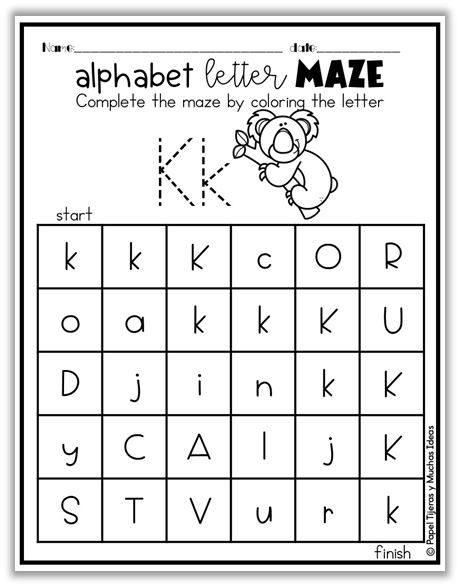Alphabet Letter Maze: Learning Through Play and Pathways
Since I began my journey as a special education teacher, I’ve learned that every child learns at their own pace and in their own way. Some need to move, others need to observe, repeat, or touch. But one thing that all children seem to love is play. And when play meets learning, magic happens.
That’s why today I want to share one of the most loved activities in my classroom: the Alphabet Letter Maze, a resource I designed with great care to support letter recognition, attention, following instructions, and of course — fun! And the best part? You can download it completely free at Papel, tijeras y muchas ideas.
What is the Alphabet Letter Maze?
This activity is designed as a visual maze, where students follow a path formed only by a specific letter (in this case, the letter A), starting at the top and working their way to the finish. The maze is filled with other distracting letters, so children must pay close attention, distinguish between uppercase and lowercase, and make thoughtful choices to find the correct path.
At the top of each sheet, I’ve included letter tracing for both uppercase and lowercase forms, so children can first trace the letter with their finger, pencil, or marker before starting the maze.
Though simple, this activity is highly effective for developing:
🔠 Visual discrimination
👁️ Attention and focus
✍️ Fine motor skills
📖 Letter recognition
😊 Confidence and independence
How did this idea come about?
The idea was born one morning when one of my students, Diego, was feeling especially restless. He had trouble staying in his seat and often got lost during more structured tasks. I thought: How can I turn letter work into a fun mission? I grabbed a sheet of grid paper, scattered various letters throughout — mostly letter A’s with some distractors — and told him:
“Your mission is to escape this maze… but you can only step on the letter A.”
Diego’s face lit up, and he solved it with a huge smile. At the end he asked, “Can I do another one?” That was the moment I knew I had something special. Since then, I’ve been creating more mazes to practice every letter of the alphabet.
How I Use It in the Classroom
I use this activity during different times of the day:
- As part of our literacy block when introducing a new letter
- In rotating centers, where students explore different hands-on activities
- After recess to help them refocus with something calm and engaging
- As a fun take-home assignment or extra practice for students who need more support
Once they complete the maze, many children like to color it or create a mini story with the letter they worked on. They love feeling like “letter detectives.” Some even invent alternate paths, which we check together to see if they still follow the rules. It’s a great opportunity to talk, reason, and most importantly — enjoy the learning process.
Student Reactions
One of my favorite parts of using this activity is seeing how excited the kids get. They often challenge each other in friendly ways: “Look, I finished it without a mistake!” or “I found the A’s faster than you!” I love how they help each other when someone gets stuck and how they cheer each other on for every small success.
Even students who normally get frustrated easily light up when they complete the maze. It gives them a real sense of pride and encourages them to try the next one.
Who Is It For?
The Alphabet Letter Maze is especially designed for preschoolers and early elementary students. However, it’s also been a great tool for older students with learning differences who are still working on letter recognition or attention skills. I've received kind feedback from other teachers and therapists who’ve used it successfully in various settings.
Free Download
As with all the resources on Papel, tijeras y muchas ideas, this activity is completely free. You can download it at the end of this post, print as many copies as you need, laminate for reuse, and adjust it to your students' needs.
Teaching reading and writing doesn’t have to be boring.
When we present content in a visual, hands-on, and playful way, learning flows naturally. I hope this resource brings as much joy and success to your students as it has to mine.
Thank you for being here and for continuing to create spaces where learning means imagining, playing, and growing. 💛













0 Comentarios